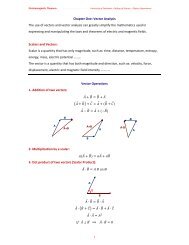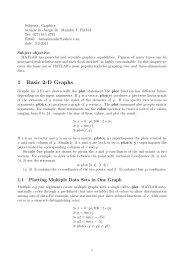Sentence Relations in the Writing of EFL Students at University Level
Sentence Relations in the Writing of EFL Students at University Level
Sentence Relations in the Writing of EFL Students at University Level
Create successful ePaper yourself
Turn your PDF publications into a flip-book with our unique Google optimized e-Paper software.
2 analyz<strong>in</strong>g, classify<strong>in</strong>g errors students make and <strong>at</strong>tribut<strong>in</strong>g <strong>the</strong>m to<br />
<strong>the</strong>ir sources; and<br />
3 Present<strong>in</strong>g suggestions and implic<strong>at</strong>ions to help teachers <strong>of</strong> English<br />
give <strong>the</strong> most relevant m<strong>at</strong>erial <strong>in</strong> <strong>the</strong>ir teach<strong>in</strong>g courses to solve <strong>the</strong><br />
overcome problem students face <strong>in</strong> rel<strong>at</strong><strong>in</strong>g senesces <strong>in</strong> <strong>the</strong>ir writ<strong>in</strong>g.<br />
3. Procedures<br />
The study is built on two procedures: <strong>the</strong>oretical and practical. The former<br />
establishes <strong>the</strong> <strong>the</strong>oretical framework <strong>of</strong> this study, while <strong>the</strong> l<strong>at</strong>ter <strong>in</strong>cludes<br />
<strong>the</strong> follow<strong>in</strong>g:<br />
1. A test has been used to check <strong>the</strong> students’ ability <strong>in</strong> us<strong>in</strong>g cohesive<br />
devices; <strong>the</strong> test is given to (138) college students <strong>of</strong> both Colleges <strong>of</strong><br />
Languages and Educ<strong>at</strong>ion for Human Sciences.<br />
2. The error analysis technique has been used to identify students’<br />
errors <strong>in</strong> <strong>the</strong> above mentioned test and to c<strong>at</strong>egorize <strong>the</strong>m accord<strong>in</strong>g to<br />
types and sub- types <strong>of</strong> error.<br />
4. The Value <strong>of</strong> <strong>the</strong> Study<br />
S<strong>in</strong>ce <strong>the</strong> study is concerned with difficulties encountered by<br />
Kurdish -learners <strong>in</strong> us<strong>in</strong>g cohesive devices, it is hoped th<strong>at</strong> its f<strong>in</strong>d<strong>in</strong>gs<br />
will be <strong>of</strong> value to Kurdish learners <strong>of</strong> English as a foreign language. It is<br />
also hoped th<strong>at</strong> <strong>the</strong> f<strong>in</strong>d<strong>in</strong>gs <strong>of</strong> <strong>the</strong> study will be <strong>of</strong> help to teachers,<br />
syllabus designers and m<strong>at</strong>erial writers <strong>in</strong> devis<strong>in</strong>g <strong>the</strong> necessary ways<br />
and means th<strong>at</strong> will help <strong>the</strong> learners overcome <strong>the</strong>se problems.<br />
5. Theoretical Background<br />
5. 1 The Concept <strong>of</strong> a Paragraph<br />
A paragraph is a small unit <strong>of</strong> writ<strong>in</strong>g th<strong>at</strong> focus on one<br />
idea. This one idea is expla<strong>in</strong>ed and developed <strong>in</strong> <strong>the</strong> paragraph.<br />
(Ruetten1997:5)<br />
Accord<strong>in</strong>g to Nash and Stacey (1980:41-2) <strong>the</strong> concept<br />
<strong>of</strong> paragraph is aes<strong>the</strong>tic, or stylistic, or text functional. The aes<strong>the</strong>tics <strong>of</strong><br />
<strong>the</strong> paragraph is its appearance on <strong>the</strong> page, and its conveyed suggestions<br />
<strong>of</strong> emphasis, rhythm and resonance as it is transl<strong>at</strong>ed <strong>in</strong>to an idea <strong>of</strong><br />
speech and delivery heard <strong>in</strong> <strong>the</strong> m<strong>in</strong>d <strong>of</strong> <strong>the</strong> reader. The stylistics <strong>of</strong> <strong>the</strong><br />
paragraph appears <strong>in</strong> its <strong>in</strong>ternal p<strong>at</strong>tern <strong>of</strong> connections and transitions<br />
from sentence to sentence, and <strong>in</strong> its management <strong>of</strong> vari<strong>at</strong>ions <strong>in</strong> sentencelength<br />
and sentence-type. The functional value <strong>of</strong> <strong>the</strong> paragraph is its role<br />
as <strong>the</strong> frame for certa<strong>in</strong> content, a phase <strong>in</strong> an argument, and an account <strong>of</strong><br />
a step <strong>in</strong> a procedure.<br />
A paragraph generally has three parts: a topic sentence, support and a<br />
conclusion. The topic sentence tells <strong>the</strong> topic (wh<strong>at</strong> <strong>the</strong> paragraph is about)<br />
and <strong>the</strong> writer’s <strong>at</strong>titude or idea about <strong>the</strong> topic. The support<strong>in</strong>g part <strong>of</strong> <strong>the</strong><br />
paragraph expla<strong>in</strong>s, describes, or develops <strong>the</strong> ma<strong>in</strong> idea given <strong>in</strong> <strong>the</strong> topic<br />
sentence. The conclusion <strong>of</strong> <strong>the</strong> paragraph usually summarizes or<br />
comments on <strong>the</strong> ma<strong>in</strong> idea. (Ostrom and Cook1993:1)<br />
5.2 Elements <strong>of</strong> a Paragraph<br />
To be as effective as possible, a paragraph should conta<strong>in</strong> each <strong>of</strong> <strong>the</strong><br />
follow<strong>in</strong>g:<br />
5.2.1Unity<br />
A paragraph should be unified. In a unified paragraph, all <strong>the</strong><br />
sentences rel<strong>at</strong>e to <strong>the</strong> topic and develop <strong>the</strong> controll<strong>in</strong>g idea. If a sentence<br />
@@@@@@@@@@@Journal <strong>of</strong> Zankoy Sulaimani. Part B. No. 29 June 2010@ 212@

















